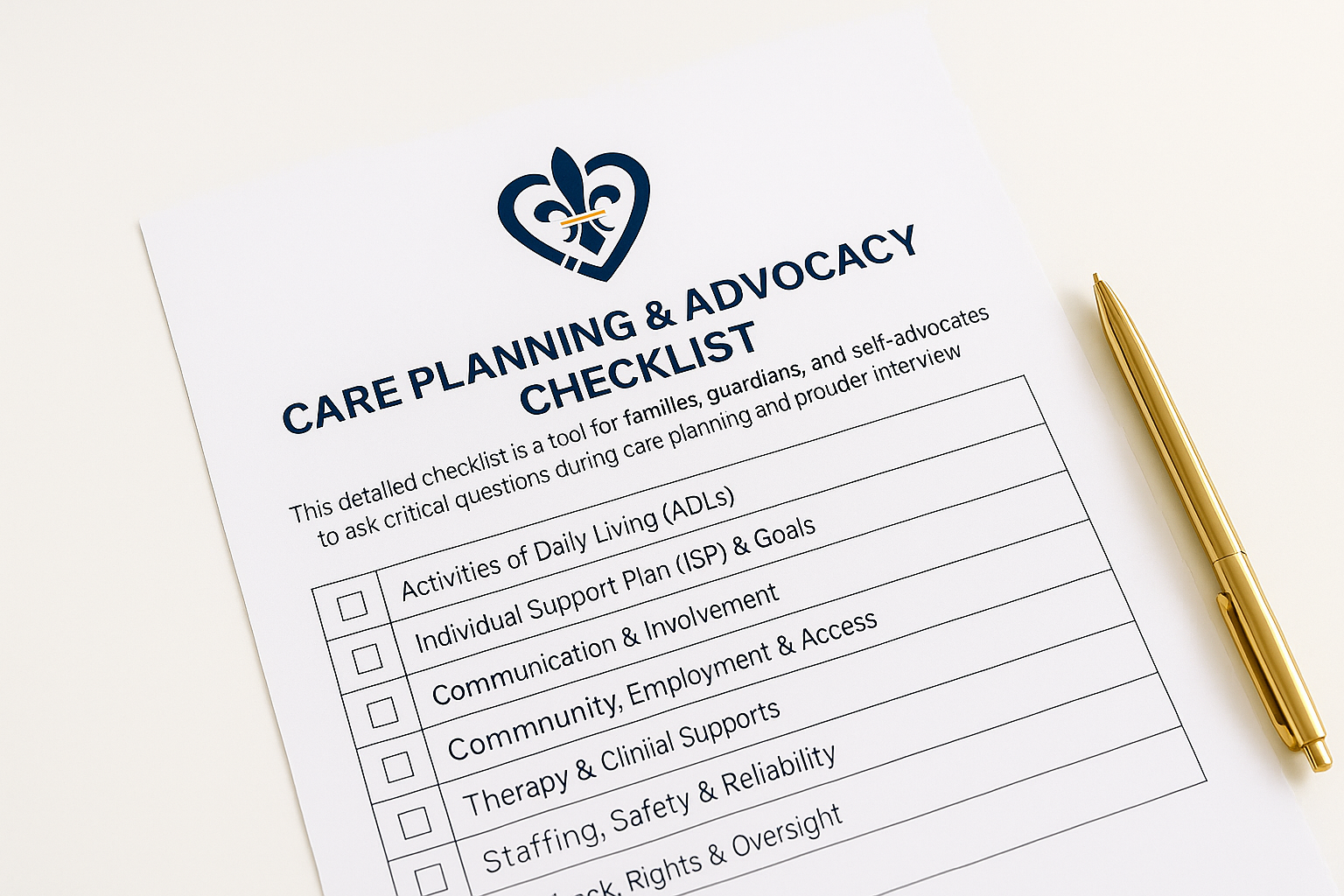
Care Planning & Advocacy Checklist
A comprehensive tool for families, guardians, and self-advocates to ensure quality care and services during provider evaluations and care planning meetings.
Your Progress
Activities of Daily Living (ADLs)
Essential daily care and support services
-
What support is provided for individuals who want to live more independently?MEDIUM
-
Are community activities age-appropriate and respectful of individual dignity?HIGH
-
How does the program measure success in community integration outcomes?MEDIUM
Therapy & Clinical Supports
Professional therapeutic services and behavioral support
-
How often are OT, PT, and SLP professionals on-site working with participants?HIGH
-
Are BCBA services available for behavioral support and assessment?HIGH
-
What documentation and progress reports are shared with families and medical teams?HIGH
-
Are behavior support plans reviewed and approved by a Human Rights Committee?HIGH
-
How are therapy goals coordinated with overall ISP objectives?MEDIUM
-
Are mental health and psychiatric services available when needed?MEDIUM
-
What training do staff receive to implement therapeutic interventions?MEDIUM
-
How are families educated about continuing therapy goals at home?LOW
Staffing, Safety & Training
Staff qualifications, safety protocols, and emergency preparedness
-
What is the current staff-to-participant ratio during different activities?HIGH
-
Are there current staffing challenges affecting service delivery or community access?HIGH
-
What safety protocols are in place for medical emergencies, behavioral crises, or natural disasters?HIGH
-
Are all staff trained in trauma-informed care and de-escalation techniques?HIGH
-
Do staff receive training in PABC and PBS?HIGH
-
What is the staff turnover rate, and how does this affect continuity of care?MEDIUM
-
Are background checks and abuse registry checks completed for all staff?HIGH
-
How often do staff receive continuing education and skills updates?MEDIUM
-
What procedures exist for reporting suspected abuse, neglect, or rights violations?HIGH
Rights Protection & Advocacy
Human rights oversight and participant advocacy
-
Who serves as the on-site Human Rights Officer, and what are their qualifications?HIGH
-
How does the program measure and track participant satisfaction?HIGH
-
Are guardians and families regularly invited to provide feedback?MEDIUM
-
What specific rights are protected, and how are they communicated?HIGH
-
Is there an independent advocate available when needed?MEDIUM
-
How are participants supported to make their own choices and decisions?HIGH
-
What grievance process exists for addressing rights violations or concerns?HIGH
-
Are restrictive interventions prohibited or strictly limited and monitored?HIGH
Quality Assurance & Outcomes
Performance monitoring and continuous improvement
-
Results of the most recent state licensing and certification audits?HIGH
-
How did the agency score on their latest DDS quality reviews?HIGH
-
What quality improvement initiatives are in progress?MEDIUM
-
Are outcome data regularly collected and analyzed (health, safety, satisfaction)?MEDIUM
-
How does the program compare to peers on quality metrics?MEDIUM
-
What external accreditations/certifications are maintained?LOW
-
Is there a formal process for implementing participant/family suggestions?MEDIUM
-
How transparent is the program about challenges and improvements?MEDIUM
Individual Support Plan (ISP) & Goals
Person-centered planning and goal development
-
How often is the ISP formally reviewed and updated?HIGH
-
Can changes be requested and implemented between annual reviews?HIGH
-
Are the individual and guardian/family actively involved in goal-setting?HIGH
-
What data collection methods track progress on each objective?HIGH
-
Are goals measurable, achievable, and meaningful to the individual?HIGH
-
How are preferences, interests, and dreams incorporated?MEDIUM
-
Is there a backup plan if primary goals aren’t being met?MEDIUM
-
Are cultural and religious preferences reflected in the plan?LOW
Communication & Family Involvement
Transparency and ongoing communication
-
What communication methods are available (email, phone, text, video, in-person)?HIGH
-
How often do guardians receive progress updates and documentation?HIGH
-
Is there a designated primary contact person for questions and concerns?HIGH
-
Are daily/weekly activity schedules shared with families?MEDIUM
-
How quickly are families notified of incidents or changes in condition?HIGH
-
Are families invited to team meetings and training sessions?MEDIUM
-
Is there a formal process for addressing complaints and concerns?HIGH
-
How are communication barriers addressed (language, tech access)?MEDIUM
Community Integration & Employment
Meaningful community participation and work opportunities
-
What specific community activities are offered weekly (shopping, recreation, volunteering)?MEDIUM
-
Are there opportunities for volunteering or internships?MEDIUM
-
What employment pathways exist (supported employment, job coaching, job development)?HIGH
-
Is accessible transportation provided for community and work programs?HIGH
-
How are interests and career goals identified and supported?MEDIUM
-
Are there opportunities for social relationships and friendships to develop?MEDIUM
Medical Care & Health Management
Healthcare coordination and medical support
-
Are staff trained annually in safe transfer techniques (e.g., Hoyer lift)?HIGH
-
Is a registered nurse on-site or on-call (g-tube, insulin, seizure management)?HIGH
-
Are all direct care staff MAP-certified?HIGH
-
How do staff accommodate preferences for bathing, dressing, and personal care?MEDIUM
-
Are dietary restrictions and preferences documented and followed?MEDIUM
-
What protocols exist for emergencies (choking, falls, medical events)?HIGH
-
How is dignity and privacy maintained during personal care?MEDIUM
-
Are adaptive equipment needs regularly assessed and updated?MEDIUM
-
How are medical appointments coordinated and documented?HIGH
-
Is there a system for tracking and following up on medical recommendations?HIGH
💡 Advocacy Tips
- Come Prepared: Review this checklist before provider meetings and bring a printed copy.
- Ask Follow-ups: If you don’t understand an answer, request examples.
- Request Documentation: Policies, training records, and outcome data.
- Trust Your Instincts: If something feels off, dig deeper or get a second opinion.
- Build Relationships: Keep open communication with key staff and administrators.
- Know Your Rights: Learn disability rights laws and state standards.
- Document Everything: Keep records of meetings and responses from providers.
- Connect with Others: Join family support groups and advocacy orgs.